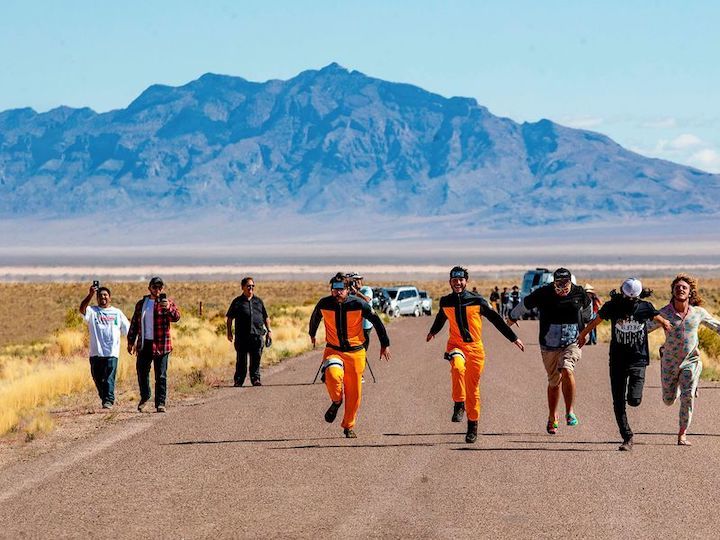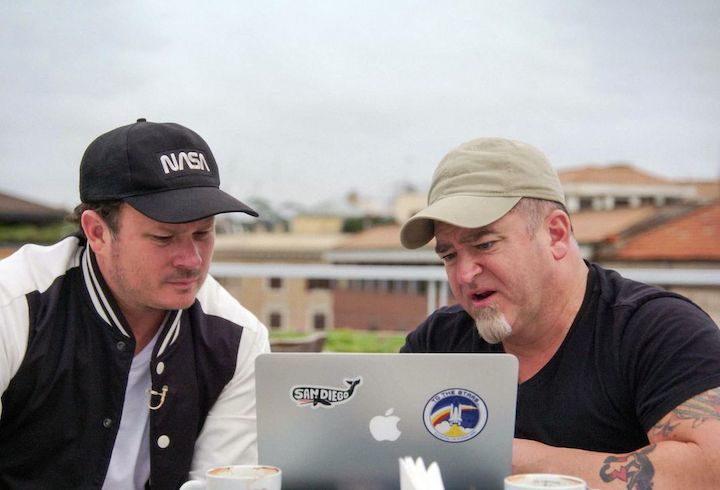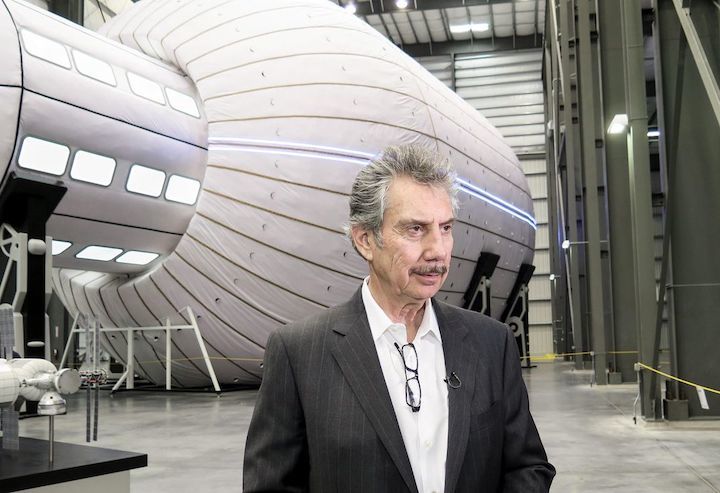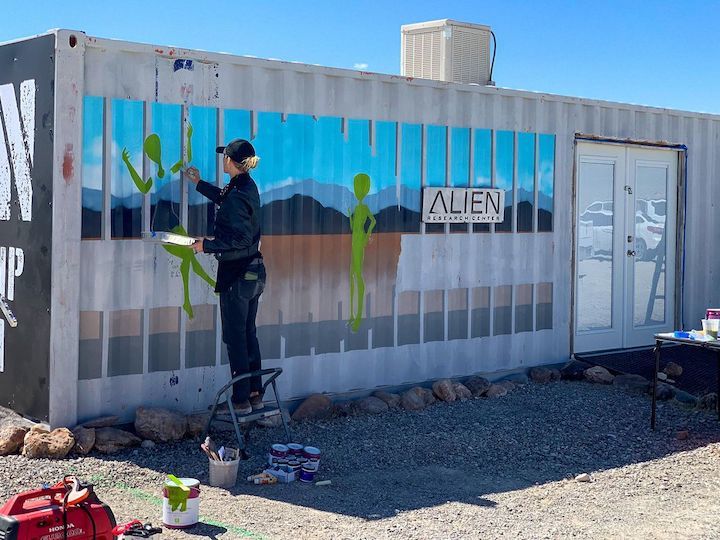2.03.2020

+++

Publicity stunt? Joke? Excuse to drink alien-themed beer? September’s #StormArea51 event in Nevada ended up being more of a lark than a bold attempt to prove that the truth is out there. But it seemed to be linked to a rise of media interest in UFOs. (Brian van der Brug / Copyright © 2019 Los Angeles Times)
UFOs are back. Or perhaps better put, interest in UFOs is again on the rise.
For most of a generation—from 1987 to 2015—media coverage of unidentified flying objects measurably declined. In the past couple of years, though, television, newspapers, and social media have made mysterious aerial sightings and the possibility of visitors from outer space big news again. Why the sudden resurgence?
A handful of events helped drive the new interest. Although unrelated, these events have been mutually reinforcing; that is, stories written about any one of them typically mention the others, leaving the impression that they add up to a single, developing narrative. The first event, and the spark that ignited today’s UFO revival, came in December 2017, when the New York Times, the Washington Post, and Politico all reported that from 2007 to 2012, the Pentagon funded a secret program to investigate reports of unidentified flying objects. The program certainly wasn’t the first of its kind—there have been numerous government fact-finding efforts dating back to the 1940s. But this latest one had never been disclosed to the public.
The Advanced Aerospace Threat Identification Program, or AATIP, as it was eventually designated, was charged with investigating sightings (mostly by U.S. military personnel) and determining whether any of the reported objects posed a threat to national security. The program came about at the request of former Nevada senator Harry Reid, who had a long-standing interest in UFOs and who at the time was Senate majority leader. With support from two other influential senators, Ted Stevens of Alaska (who had had his own UFO experience as an Army Air Forces pilot during World War II) and Daniel Inouye of Hawaii, Reid arranged for funding to be inserted in the defense appropriations bill for investigating unexplained aerial phenomena. There was nothing new or unusual about a prominent politician ordering up a UFO investigation. The question of “what’s really going on up there” has drawn bipartisan attention for decades, from Gerald Ford to Jimmy Carter (who as Georgia governor once filed a UFO report) to Hillary Clinton.
All told, it was estimated that AATIP spent around $22 million during its five years of Pentagon funding. As part of the investigation, the defense department contracted with Las Vegas-based Bigelow Aerospace—hotel tycoon Robert Bigelow is a friend of Reid with a shared interest in UFOs—to explore the possibility of reverse-engineering any craft that was imaged or captured. Bigelow won the contract, Reid explained to New York magazine interviewer Eric Benson in 2018, because he’d already been researching the subject for years and “had spent his own money first.” Today, Bigelow’s company is best known for designing inflatable space habitats for future astronauts and space tourists. (See “The Future of Construction in Space,” September 2015.) But for the past quarter century or so, Bigelow has been deeply involved in researching UFOs and paranormal phenomena, first through his National Institute for Discovery Science and then at his 480-acre Skinwalker Ranch in Utah. As he explained in a “60 Minutes” interview in May 2017, he is “absolutely convinced” Earth has been visited by extraterrestrials.
Part of what made the 2017 news stories so compelling is that they were accompanied by two videos released to the media, with a third following months later. The footage purported to show U.S. Navy jet encounters with unusually shaped, fast-moving aircraft. The videos quickly went viral and have become the subject of fevered speculation by UFO investigators. It wasn’t until long after they first came to light, however, that the Navy confirmed the dates of the videos. They had been recorded in 2004 and 2015 by pilots flying off two aircraft carriers, the USS Nimitz and the USS Theodore Roosevelt, off the coasts of California and Florida. Joseph Gradisher, a spokesman for the office of the Deputy Chief of Naval Operations for Information Warfare, acknowledged that the three occurrences remained “unidentified,” but said the Navy would not offer “any hypothesis or conclusions in regard to the objects contained in the referenced videos.”
The key figure in all the media reports about the Pentagon UFO investigation was Luis Elizondo, known informally as Lue. A career military intelligence officer, he identified himself to reporters as the past head of AATIP, up until the time its official funding ended in 2012. It was Elizondo who provided the press with details about the UFO program’s work, and Elizondo who helped arrange for the Navy videos to be declassified and shared with the general public. Right from the start, he attracted nearly as much media attention as the aerial mysteries he supposedly was investigating. Following in the footsteps of past UFO crusaders like author Donald Keyhoe, psychologist David Saunders, and astronomer J. Allen Hynek (an advisor to the Air Force’s Project Blue Book of the 1950s and 1960s), Elizondo portrayed himself as a patriotic whistleblower. In a letter resigning from the defense department in October 2017, he wrote that he was frustrated by the lack of concern and resources the Pentagon devoted to “what could be a tactical threat to our pilots, sailors, and soldiers, and perhaps even an existential threat to our national security.”
Beyond Elizondo’s own statements to the press, details about the UFO program’s operations have been scant. In January 2019, the Defense Intelligence Agency responded to a request from the U.S. Senate Committee on Armed Services for more information about its work. An official at the agency confirmed that “the purpose of AATIP was to investigate foreign advanced aerospace weapon threats from the present out to the next 40 years” and provided a list of all 38 reports associated with the program. That list has raised eyebrows. Some of the research topics—high-energy laser weapons and alternative propulsion systems, warp drives, antigravity, traversable wormholes, stargates, and invisibility cloaking devices—struck skeptics as the stuff of science fiction. UFO enthusiasts, meanwhile, were left wondering why there was no mention of sightings like the ones in the Navy videos released to the media. Because a number of reports on the AATIP list appeared to have the same titles as reports already in the public domain, some people wondered if they’d been repurposed, or if the program had merely done a literature review.
The second UFO-related event that caught the media’s attention around the same time as the AATIP disclosure was the creation of a new, for-profit company called To the Stars Academy of Arts and Sciences. Its stated mission is “to investigate the outer edges of science and unconventional thinking” via “an entertainment, science, and aerospace consortium that engages with global citizens.” Launched in October 2017—five years after the Pentagon-funded study ended—its co-founder and chairman of the board is guitarist Tom DeLonge, formerly with the rock band Blink-182. Also joining the team as director of global security and special programs: Luis Elizondo.
Last March, To the Stars announced that Elizondo, DeLonge, and four other company executives would be featured in a six-part television series to air on the History Channel, called “Unidentified: Inside America’s UFO Investigation,” and that DeLonge would be executive producer. The series premiered on May 31 to robust ratings, with each episode reaching around a million viewers. The show focused on the highly publicized U.S. Navy videos but also explored UFO sightings in Italy, Mexico, and the United Kingdom. Interviews with witnesses were combined with dramatic recreations.
But the real star of the show was Lue Elizondo, with To the Stars members Steve Justice, Chris Mellon, DeLonge, and Hal Puthoff assuming supporting roles, along with Politico correspondent Bryan Bender. Rather than being a straightforward documentary about UFOs, “Unidentified” cast Elizondo as a burly, intrepid, backpack-toting crusader seeking to expose the truth in the face of a stonewalling government bureaucracy and a culture of ridicule. In doing so, the History Channel followed a long tradition within ufology of portraying the UFO investigator as a heroic figure determined to tear away the veil of secrecy surrounding extraterrestrial visitors.

The stars of To the Stars Academy of Arts and Sciences: Rocker Tom DeLonge (left) and former military intelligence officer Luis Elizondo figured prominently in a six-part History Channel series. (A+E Networks)

Naturally, there have been skeptics all along. Within days of the release of the Nimitz videos purporting to show a UFO accelerating at a rate defying physics, science writer Mick West showed that the object’s peculiar movement was the result of a change in the camera’s zoom level. Writing for Skeptic magazine, Robert Sheaffer detailed how witnesses in one incident contradicted one another, and how some of the anomalous objects appearing on radar may have been due to a computer upgrade.
The defense department has been little help in clearing up these mysteries. Since the emergence of UFOs in popular culture in the early 1950s, some investigators have come to expect silence and denials from government officials when confronted with claims of sightings. Others view these tight-lipped responses as evidence of an official cover-up and conspiracy about alien visitors. Still others consider them an inevitable, albeit misguided, reaction by nervous authorities involved in national security. Whatever the reason, official government sources very rarely comment on new sightings, leaving the field open to all types of speculation.
Many in the UFO community were therefore encouraged when Politico’s Bryan Bender, who helped break the news about AATIP in 2017, reported last April that the Navy was drafting new guidelines for its personnel to report encounters with unidentified flying objects. The Navy even appeared to be switching to the designation Unidentified Aerial Phenomena (UAPs) preferred by UFO researchers, as the British Ministry of Defence had already. Navy spokesman Joseph Gradisher confirmed to the Washington Post that the Navy’s UFO reporting guidelines were being updated, with the purpose of collecting more information for data analysis. But, he cautioned, don’t expect the data to be shared. “(Any) report generated as a result of these investigations will, by necessity, include classified information on military operations,” he said. “Therefore, no release of information to the general public is expected.”
Since then, information from the Navy has been sparse, although documents released in response to Freedom of Information Act requests have shed more light on the rationale for the new UFO reporting guidelines. Answering reporters’ questions last spring, Gradisher said the “wide proliferation and availability of inexpensive unmanned aerial systems, such as commercially available quadcopters, has increasingly made de-confliction an issue for our aviators.” In other words, drones have become common sources of confusion for pilots. Said Gradisher, “Sightings of this nature have increased in frequency from 2014 until now.”
Suddenly the military’s new interest in UFOs began to seem more mundane than mysterious. But other, unrelated news stories helped keep the extraterrestrial narrative going. Around the same time the AATIP program was revealed, scientists discovered the first interstellar object ever seen to enter our solar system. Astronomers Shmuel Bialy and Abraham (Avi) Loeb of the Harvard-Smithsonian Center for Astrophysics raised the possibility that the unusual comet-like object, dubbed ‘Oumuamua (Hawaiian for “scout”), could, conceivably, be an alien spacecraft. Later observations showed it to be most likely natural in origin, as most astronomers expected. But by that time, the notion that it possibly was artificial had become a social media meme.

Then came the “storming” of everyone’s favorite secret government installation, Area 51 in Nevada. In June, a college student by the name of Matty Roberts created an event on Facebook as a joke. He called it “Storm Area 51, They Can’t Stop All of Us.” The military base north of Las Vegas has been the site of classified aircraft testing since the mid-1950s, but beginning in the 1970s, a number of self-styled whistleblowers associated with the aerospace industry began claiming that it also was testing captured extraterrestrial spacecraft and holding alien prisoners and corpses. Many in the UFO community found their claims persuasive.
The #StormArea51 event may have been meant as a joke, but by early September, more than two million people had indicated on Facebook that they would attend. Roberts changed the nature of the event and decided to hold what he called an “Alienstock” music festival in the desert town of Rachel, which he later moved to downtown Las Vegas, with Budweiser as a sponsor selling alien-themed beer. In the meantime, other events were planned nearer to Area 51, including Hiko, Nevada (home of the Alien Research Center, a self-styled “Area 51 Gateway”), where events and speakers were scheduled for the true believer crowd.
As the date drew closer, the Air Force and local police warned potential attendees that trespassers on Area 51 property would be arrested. On the eve of the event, USA Today reporter Ed Komenda said officials in the area were expecting “anywhere from 50 people, maybe 500 people, maybe 10,000 people.” Other news outlets and blogs either laughed off the event or bemoaned it as a pitfall of social media culture, where silly memes and fake news can quickly take on a life of their own.
In the end, the happening had more the feel of a festival than a raid. Lincoln County sheriff Kerry Lee told the Associated Press that about 100 revelers showed up at the back gate of Area 51 at around 3 a.m., with another 40 people going to the lesser known Tikaboo Valley gate. Slightly more people showed up during the day, but a source at the Independent reported that “the event is clearly fairly aimless: dozens of people stood around, while sheriffs watch on.” The “Area 51 Basecamp” event at the Alien Research Center in Hiko was called off after the first day due to small numbers. Back in Las Vegas, Roberts voiced satisfaction about the turnout for the party he organized, and vowed it would be an annual event.
So what should we make of this latest UFO mini-craze? Evidence from the United States, Canada, and the United Kingdom shows that the number of sightings has been holding steady or growing for decades, so last year was nothing special in that regard. There was no apparent uptick in public reports of mysterious flying objects.
The Navy bears some responsibility for the recent media focus on UFOs, due to its piecemeal and selective approach to revealing details on reported encounters, which only feeds suspicions that the government knows more than it is telling (as 69 percent of Americans believe, according to a Gallup poll taken in September). But UFO incidents in 2019 did not just happen. They were promoted. Enthusiasts, journalists, cable TV networks, academics, bloggers, and To the Stars Academy all helped keep the topic in the public eye, and all benefited from the attention.
Throughout the history of UFO sightings, it has never been enough merely to point to isolated weird events. What’s needed are storylines with characters, drama, suspense, and plot twists. And that’s what UFO believers were given in the past year or two. Secret videos. Respectable witnesses. An eccentric entrepreneur. A celebrity advocate. A determined whistleblower. Secretive government officials bent on stonewalling the truth. None of these characters are new to the world of UFOs. Only the cast has changed.
Quelle: Air&Space
